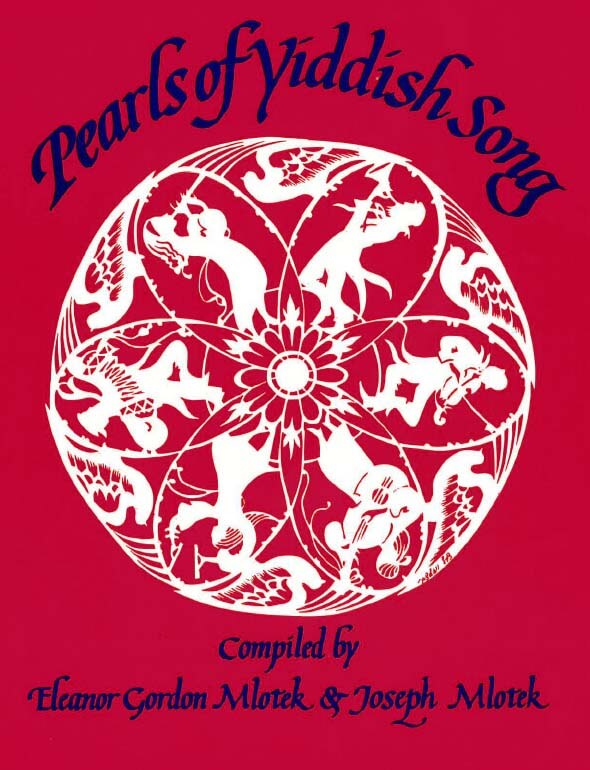Words by Peretz Hirshbeln (1880-1948); music by Lazar Weiner (1897-1982). Published under the title “A maysele” (A story) by Jibneh Verlag, Vienna, 1936. The song is based on one of the Sabbath zmires (table songs) that describe the wonders of Elijah the Prophet.

Once upon a time there lived a Jew and his wife
as poor as anything:
They had two daughters,
but didn’t have a penny…
Oh, how can you get a dowry
for your daughters to be married?
Just listen to this, what happened
was no laughing matter.
A guest came for Shabes;
they opened the door wide for him.
It was, oh wow, it was
Elijah the Prophet.
They prepared everything good for him
the place was his;
After Havdole, he went quietly,
and left behind a blessing.
Buckets of milk, rivers of wine, an ocean of coins
fortune shone on them;
But the world became too small for them,
may it not happen to anyone.
Then a great punishment came
for their bitter sin;
The milk and the wine ran out
and not a scrap of a coin was left.
Once upon a time there lived a Jew and his wife
as poor as anything:
They had two daughters,
but didn’t have a penny…
Note: Havdole = the Sabbath’s closing ritual
Geven a mol a yid mit a yidene,
Kabtsonimlekh groyse vi di velt:
Hobn zey tekhterlekh tsvey gehat,
Nor on a groshn gelt…
Oy, vu nemt men khotsh nadan,
Di tekhter khasene makhn?
Hert nor, hert, vos iz geshen —
A mayse gornit tsum lakhn.
Kumt oyf shabes an oyrekhl;
Efnt men breyt di tir far im.
Un geven iz dos, ay, geven —
Eyliyohu hanovi.
Greyt men im fun al dos guts,
Dos ort far im gelozn;
Nokh havdole shtil avek,
A brokhe ibergelozn.
Emer milkh, taykhn vayn, rendlekh a yam
Hot dos mazl zey gebrakht;
Iz gevorn karg far zey di velt,
Nit far keyn yidn gedakht.
Gekumen iz di groyse shtrof
Far dem khet dem harbn;
Oysgerunen milkh un vayn,
Fun rendlekh nor a sharbn.
Geven a mol a yid mit a yidene,
Kabtsonimlekh groyse vi di velt,
Hobn zey tekhterlekh tsvey gehat,
Nor on a groshn gelt…
געװען א מאָל אַ ייִד מיט אַ ייִדענע,
קבצנימלעך גרױסע װי די װעלט;
האָבן זײ טעכטערלעך צװײ געהאַט,
נאָר אָן אַ גראָשן געלט. . .
אײַ, װוּ נעמט מען כאָטש נדן,
די טעכטער חתונה מאַכן?
הערט נאָר, הערט, װאָס איז געשען —
אַ מעשׂה גאָרניט צום לאַכן.
קומט אױף שבת אַן אורחל;
עפֿנט מען ברײט די טיר פֿאַר אים.
און געװען איז דאָס, אײַ, געװען —
אליהו הנבֿיא.
גרײט מען אים פֿון אַל דאָס גוטס,
דאָס אָרט פֿאַר אים געלאָזן;
נאָך הבֿדלה שטיל אַװעק,
אַ ברכה איבערגעלאָזן.
עמער מילך, טײַכן װײַן, רענדלעך אַ ים
האָט דאָס מזל זײ געבראַכט;
איז געװאָרן קאַרג פֿאַר זײ די װעלט,
ניט פֿאַר קײן ייִדן געדאַכט.
געקומען איז די גרױסע שטראָף
פֿאַר דעם חטא דעם האַרבן
אױסגערונען מילך און װײַן,
פֿון רענדלעך נאָר אַ שאַרבן.
געװען אַ מאָל אַ ייִד מיט אַ ײִדענע,
קבצנימלעך גרױסע װי די װעלט;
האָבן זײ טעכטערלעך צװײ געהאַט,
נאָר אָן אַ גראָשן געלט. . .
Song Title: Geven A Mol A Yid Mit A Yidene

First published in 1988 as Pearls of Yiddish Song: Favorite Folk, Art and Theatre Songs, this anthology contains 115 songs. Some material had never been published, while others, included in rare song collections or sheet music, were largely inaccessible. The songs presented reflect Jewish life in Eastern Europe and the United States and depict childhood, love, family celebrations, poverty, work and struggle. There are also songs from the Hasidic and Maskilic movements, songs of Zion and of America, as well as songs from the Yiddish theater.
The title of this anthology derives from the weekly two-page feature column “Pearls of Yiddish Poetry,” which the compilers Yosl and Chana Mlotek initiated in 1970 in the Yiddish newspaper Der Forvertz (the Yiddish Daily Forward). Hundreds of readers from around the world — including authors, composers, singers, actors — became co-participants in this collective folk project and recalled melodies, lines, fragments, stanzas and their variants of songs, poems, and plays which they had heard in their youth. At first, readers sent in only written material. Later, they also taped songs on cassettes, many of whose melodies had, until then, never been recorded. They also identified and supplied missing information regarding lyricists, poets, and composers and described the circumstances surrounding the songs’ origins, their dissemination, diffusion and impact.